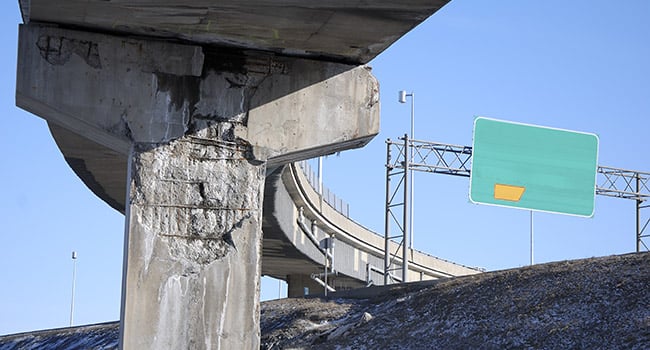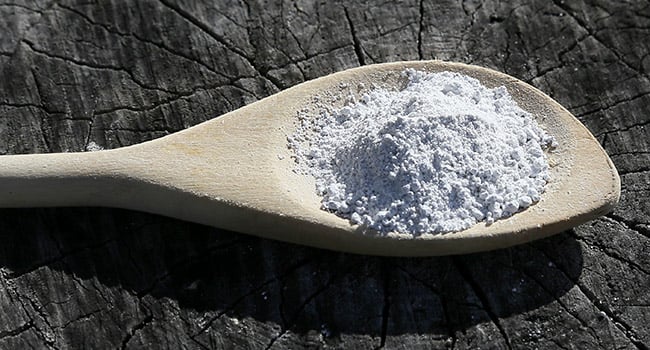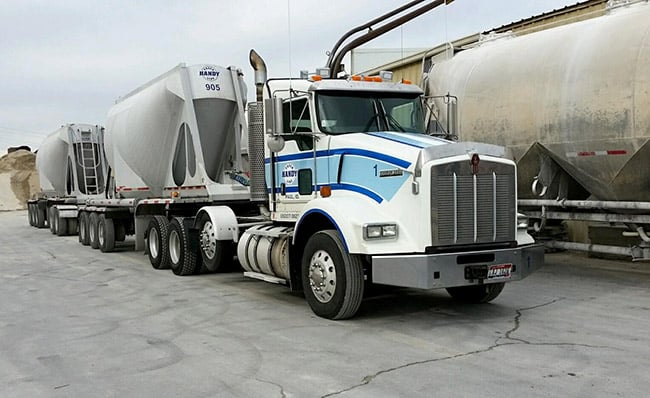Peformance-Boosting Pumice Pozzolan

ABOVE: Failing overpass support made from standard concrete (without pozzolan density and strength improvments) suffering from sulfate, chloride, and freeze-thaw attacks. BELOW: Pumice pozzolan powder (HP Grade DS325).


Hess ships bulk pozz to batch plants in pneumatic rail- or truck-borne containers.
IT’S EASY TO GET JADED by the constant stream of tech and product-tweak advances promising all kinds of amazing results. Sometimes, embracing the latest and greatest is more trouble than it appears to be worth.
A much rarer occurrence is when we rediscover a valuable technology that was lost to history—one that easily trumps what we use now. One that centuries of evidence has proven as effective. Case-in-point: Roman Concrete. In particular, the significant performance boost our modern Portland cement-based concrete gets from the addition (at a percentage of cement replacement) from the same pozzolanic catalyst they used: pumice.
Two thousand years ago, Roman engineers discovered that by adding fine-grained pumice, or “pozzolana” to their hydrated lime cement, the result was a strong, durable concrete[01]. They may not imagined their concrete structures still be standing some two millennia later, but they knew they had good stuff, and it enabled daring feats of engineering on a huge scale. The evidence of the quality of their concrete is undeniable. We certainly can’t say the same about our own modern concrete infrastructure—it’s crumbling beneath us.
01—For additional information, see Pumice and Roman Concrete.
Fly Ash as a Pozzolan
The construction industry widely “rediscovered” the benefits of pozzolan-enhanced concrete when the coal-fired power generation industry was looking for a way to utilize the fly ash waste they were scrubbing from the stacks. They found that fly ash had the pozzolanic characteristics and chemical makeup to improve Portland cement-based concrete, and one class, in particular (Class F), was an adequate mimic for natural pumice pozzolan.

Since the 1940s, Class F fly ash has been widely used in concrete for two reasons: 1—negligible cost, and 2—standard Portland cement concrete suffers from a host of ills; the main troublemaker being unconverted Calcium Hydroxide, a by-product of the hydration reaction between water and Portland cement.
But using fly ash as a pozzolan has issues of its own. The ever-tightening emissions restrictions on coal-burning power plants and the mounting economic pressures faced by the coal-fired energy sector have created an availability problem that exacerbates the problems with fly ash that already existed—by nature of its by-product origin, fly ash is a contaminate-loaded chemical cocktail with frustrating handling and performance inconsistencies.
With the ongoing contraction of coal-fired power industry and the subsequent limits to fly ash availability, concrete engineers are turning to natural pozzolans, either wholly or as blended products of natural pozzolan and fly ash.
The Original Pozzolan
Sometimes, the original is still the best. Quantifying research on the pozzolanic character of pumice—Hess Pumice, in particular—and its effect on concrete was conducted by the University of Utah and the University of Texas-Austin (and others), provides the hard data concrete engineers need to formulate and specify mix designs that result in concrete that is up to challenge of its environment. In every key performance category, pumice-blended cement delivers[02]. Of particular interest in the two-year study done by the University of Texas-Austin—a study commissioned by the Texas DOT to evaluate alternative SCMs to fly ash—is the inclusion of Class F fly ash in the same concrete strength and durability tests, laying down a comparative baseline. The research quantified pumice as an ideal SCM replacement for fly ash across the board[03].
Some concrete engineers are gaining more consistent performance and attacking location-specific durability needs with mix designs that incorporate both fly ash and a small percentage of pumice pozzolan—say to boost sulfate resistance in an aggressive sulfate soils environment. (Pumice-blended cement gives concrete a Class 3 sulfate exposure rating).
02—Download a summary of the pumice pozzolan research from the University of Texas-Austin and the University of Utah.
03—Download a summary of the University of Texas-Austin research quantifying fly ash vs. pumice performance data.
Why Pozzolan?
When Calcium Hydroxide (CH) is created, that leaves less cement powder for converting into Calcium Silicate Hydrate (C-S-H)—the all-important binding agent in concrete. The result is a cured concrete with less density and strength than it should—and could—have. To make matters worse, not only does by-product CH contribute nothing to concrete performance and durability, it instigates a handful of problems that actively work against and drastically affect the integrity of the concrete.
Some of the CH migrates to the surface, riddling the curing concrete with a network of interconnected pores. These pores later allow ingress of moisture, which not only causes freeze-thaw damage, but often carries destructive chemicals into the concrete matrix. Sulfates react with residual calcium hydroxide, creating expansive gels which cause internal cracking. Chlorides attack reinforcing steel. The CH that reaches the surface reacts with Carbon Dioxide in the air to become Calcium Carbonate, resulting in surface staining known as efflorescence.
Additionally, reactive aggregates release Silicic Acid, which combines with CH to cause an Alkali-Silica Reaction (ASR)[04], which relentlessly shatters concrete from within.
Excising the destructive evils which Calcium Hydroxide within concrete is simple: introduce a natural pumice pozzolan to the concrete mix design. The finely-graded pumice ignites a concrete-enhancing pozzolanic reaction, capturing the potentially destructive Calcium Hydroxide and converting it into additional Calcium Silicate Hydrate glue—the good stuff. The result? The additional binding agents within the concrete densify and strengthen the matrix while the deleterious effects are mitigated or eliminated.
The advantages of a pozzolanic charge don’t stop there. Extensive and on-going ASTM-standard research details how pumice pozzolans will also reduce heat-of-hydration damage and increase long-term compressive strength. This body of research provides the necessary data for the industry to confidently embrace and apply the needed benefits of pumice pozzolan.
04—For additional information, see ASR Mitigation with Pumice-Blended Cement on this site.
Additional Benefits From Pozzolan
By incorporating a carefully refined pumice pozzolan into a concrete mix design, additional benefits are realized:
—The concrete reacts and cures predictably pour after pour…something that can not be said for industrial by-product pozzolans.
—Pure pumice pozzolan is the environmentally safe, health-friendly pozzolan choice—free of crystalline silica, arsenic, beryllium, cobalt, lead, mercury, selenium and other hazardous contaminants.
—Because pumice is naturally calcined by nature, pumice pozzolan has a negligible carbon footprint. When used as a supplementary cementitious material to replace up to 20 percent of the Portland cement, by weight, in a concrete mix, the immense carbon footprint of concrete is significantly decreased on a pound-for-pound basis.
As for the pumice from the Hess deposit, in particular, there are two additional benefits: our pozz has a whiteness that scores a GE brightness of 84, resulting in a beautiful, consistently light-colored concrete that is ideal for use in precast and GFRC applications where color matching is critical. Additionally, our pumice pozz has a specific gravity of 2.35. Most other pozz products are 2.6 or higher, meaning economically, you can use less Hess Pozz, by weight, to achieve the same or even greater benefit.
Hess Pozz; Hess UltraPozz
Hess Pumice Products produces two grades of pumice pozzolan: Hess Standard Pozz (HP Grade DS325) and Hess UltraPozz (HP Grade NCS-3).
Hess’ pumice products are shipped worldwide by the bag, pallet, or bulk container; by truck, rail, and ocean container. We distribute scores of pumice grades and pumice-blended products to thousands of customers across six continents. Hess Pumice is the world leader in processed pumice mining, production, and beneficiation.
LINKED RESOURCES
—Download a summary of the Pumice Pozzolan Research (including the effectiveness of pumice pozzolan to flatline ASR) from the University of Texas-Austin and the University of Utah.
—Download a summary of the University of Texas-Austin Research quantifying fly ash vs. pumice performance data.
—Visit the Hess Pozz website.

